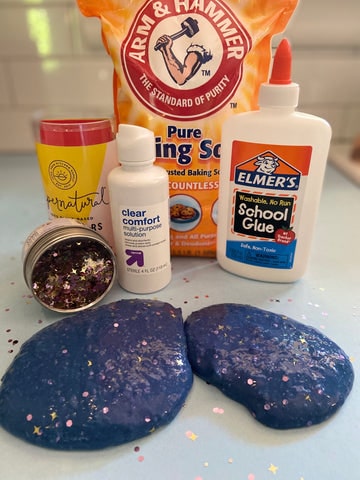Ultimate Guide to Safe and Fun Slime Ingredients for Kids
Hey there, awesome parents! Are you ready to dive into the ooey-gooey world of slime-making with your kiddos? Slime isn’t just a stretchy and squishy plaything; it’s a universe of creativity waiting to be explored by little hands and imaginative minds. But as responsible parents, we know safety comes first. That’s why we’ve put together this sparkle-filled guide to help you find the safest and most fun ingredients for making homemade slime!
What Makes Slime, Well, Slime?
Before we get our hands sticky, let’s understand the science behind slime. At its core, slime is a non-Newtonian fluid, which means it doesn’t follow the usual laws of liquid and solid states. It can pour like a liquid, yet resist like a solid when you squeeze it. This magical transformation happens thanks to a process called polymerization, where ingredients bond together at the molecular level to create a substance that’s irresistible to play with. Exciting, right?
The Basic Ingredients for Homemade Slime
Creating the perfect batch of homemade slime can be as simple or as complex as you want it to be. To start, you’ll need a few basic ingredients, which you’ll find right in your home or at a local store:
- Glue: The backbone of any slime recipe is good old-fashioned PVA glue. White or clear school glue works best, creating a perfectly gooey base for your slime.
- Borax Solution: A bit of borax mixed with water creates an activator that turns your glue into slime. Note: Borax should be handled with care, and always under adult supervision.
- Baking Soda: Adding a touch of baking soda helps thicken the slime mixture and provides more elasticity.
- Contact Lens Solution: If you’re looking for a borax-free alternative, a contact lens solution containing boric acid can also act as an activator.
- Food Coloring: Make your slime stand out with a few drops of food coloring. Choose any shade of the rainbow to make your slime as vibrant as you wish!
A Special Note on Safety
When it comes to making slime with kids, safety is a top priority. While most ingredients are non-toxic, it’s essential to keep in mind that some can cause irritation or allergic reactions. Always supervise your kids during slime time, make sure they wash their hands thoroughly afterward, and keep slime away from mouths, eyes, and ears. It’s also important to store your slime ingredients properly, and to dispose of any old or dried-out slime responsibly.
Slime Safety Tips:
- Always use a clean, dry bowl and tools for mixing your slime ingredients.
- Measure out materials carefully, and avoid any unnecessary contact with skin or face.
- If your child has sensitive skin, consider wearing disposable gloves during preparation.
- Conduct a patch test with the slime on your child’s skin to check for reactions before play.
- Remember to discard slime that has come into contact with dirt or other contaminants.
Now that you’re equipped with the basics, it’s time to grab your glitter and glue, gather the little ones, and get ready for an exciting slime adventure! In our next section, we’ll unveil some creative and colorful variations to standard slime recipes that will bring even more joy to your slime-creating session. Stay tuned!
Remember, making slime is not just playtime—it’s a bonding experience with your children and a delightful opportunity to teach them about the wonders of science in a hands-on environment. So, let’s get mixing and make some memories with the marvellous world of homemade slime!

5 Things Parents Should Know When Preparing Slime Ingredients
As you gear up for a session of slime-making fun, here are five crucial things every parent should be aware of to create a smooth and safe slime-making experience:
1. Slime Ingredient Quality is Key
- Always opt for high-quality, non-toxic glue. This will ensure that your slime is safe for play. If you have concerns about allergies, look for hypoallergenic glue brands.
- When using borax, ensure it is pure and free from contaminants. Better yet, for a safer option, consider alternatives like saline solution or liquid starch.
2. Understand the Science Behind Ingredients
- Familiarize yourself with the chemical reactions that occur during slime-making. This knowledge not only helps in explaining the process to curious kids but ensures that you can troubleshoot if the slime doesn’t turn out as expected.
3. Pre-Measure Ingredients to Avoid Messes and Mistakes
- Having all ingredients pre-measured can streamline the process and prevent potential mishaps. This is especially helpful if you have multiple little helpers eager to get involved.
4. Slime Customization Should Be Safe and Creative
- Encourage your children’s creativity by incorporating safe, non-toxic items like glitter, foam beads, or food coloring. However, ensure these additives are child-friendly and won’t pose a choking hazard.
5. Be Ready for Cleanup and Storage
- Have a plan for cleanup. Non-stick mats, disposable containers, and having paper towels on hand can make post-slime-making cleanup a breeze.
- Think ahead about where you’ll store your slime. Airtight containers are perfect to keep slime fresh and prevent it from drying out.
Making slime is a versatile activity, and with the right knowledge, it can be a fantastic way to engage with your children safely. With these guidelines in mind, you’re now ready to turn this playful craft into an unforgettable experience. So, whip out those stir sticks, and let’s make some slime magic!
Exciting Slime Recipe Variations
Ready to take your basic slime recipe to the next level? Here are some fantastic variations that will not only add some pizzazz to your slime but will get your kids excited to play and learn:
Glitter Galore Slime
- Simply add your favorite glitter to the basic recipe. This will give your slime that extra twinkle and wow factor!
Fluffy Cloud Slime
- For a fluffy texture, mix in shaving cream with your glue before adding the activator. The result is a light and fluffy cloud-like slime that’s irresistible to squish.
Scents of Fun Slime
- A drop or two of non-toxic essential oils can add a pleasant aroma to your slime. Just ensure the scent is not overpowering and is safe for your child.
Color-changing Slime
- Thermochromic or photochromic pigments mixed in with the slime can create color-changing effects either with temperature changes or under sunlight, making for a magical playtime experience.
Eco-friendly Slime
- Consider using biodegradable glitter and natural colorants to make your slime-making session more environmentally friendly.
With these exciting variations, your children can enjoy a whole spectrum of slime types, each with its unique texture and style. So, happy slime-making, and let your creativity burst with every squish and stretch!
See more great Things to Do with Kids in New Zealand here. For more information see here
Disclaimer
The articles available via our website provide general information only and we strongly urge readers to exercise caution and conduct their own thorough research and fact-checking. The information presented should not be taken as absolute truth, and, to the maximum extent permitted by law, we will not be held liable for any inaccuracies or errors in the content. It is essential for individuals to independently verify and validate the information before making any decisions or taking any actions based on the articles.




